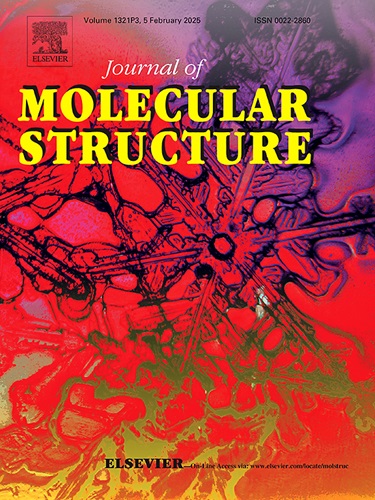Carboxylated chitosan-phthalate/ZrO2 nanocomposite for removal of methylene blue dye: Characterization and adsorption modeling via response surface methodology
IF 4
2区 化学
Q2 CHEMISTRY, PHYSICAL
引用次数: 0
Abstract
Herein, phthalic anhydride was employed to carboxylate the chitosan polymer modified with metal oxide nanoparticles (zirconium dioxide, nano ZrO2, NZ) to obtain efficient adsorbent of carboxylated chitosan-phthalic anhydride/ZrO2 biocomposite (CTS-PHT/NZ) for the removal of methylene blue (MB) dye. The properties of CTS-PHT/NZ were investigated via several techniques, i.e., FTIR, BET, CHN![]() O, FESEM-EDX, and XRD. Response surface methodology was applied for modeling the adsorption parameters, including the dosage of CTS-PHT/NZ (ranging from 0.02 to 0.08 g), the time (10 to 110 min), and the pH (ranging from 4 to 10). The results of adsorption isotherms indicated that the Freundlich model provided the best fit for the MB adsorption. In contrast, the kinetic outcomes demonstrated that both pseudo-second-order and pseudo-first-order models adequately characterized the MB adsorption. The adsorption capability of CTS-PHT/NZ is 240.1 mg/g. The MB uptake on the CTS-PHT/NZ ascribes to several interactions, including electrostatic, H-bond interactions, π-π, and n-π stacking. The newly developed CTS-PHT/NZ adsorbent represents a significant advancement in the field of dyeing wastewater remediation, offering high promise for achieving exceptional efficiency in cationic dye removal.
O, FESEM-EDX, and XRD. Response surface methodology was applied for modeling the adsorption parameters, including the dosage of CTS-PHT/NZ (ranging from 0.02 to 0.08 g), the time (10 to 110 min), and the pH (ranging from 4 to 10). The results of adsorption isotherms indicated that the Freundlich model provided the best fit for the MB adsorption. In contrast, the kinetic outcomes demonstrated that both pseudo-second-order and pseudo-first-order models adequately characterized the MB adsorption. The adsorption capability of CTS-PHT/NZ is 240.1 mg/g. The MB uptake on the CTS-PHT/NZ ascribes to several interactions, including electrostatic, H-bond interactions, π-π, and n-π stacking. The newly developed CTS-PHT/NZ adsorbent represents a significant advancement in the field of dyeing wastewater remediation, offering high promise for achieving exceptional efficiency in cationic dye removal.
羧化壳聚糖邻苯二甲酸酯/ZrO2纳米复合材料去除亚甲基蓝染料:表征和响应面法吸附建模
本文采用邻苯二酸酐对金属氧化物纳米粒子(二氧化锆、纳米ZrO2、NZ)修饰的壳聚糖聚合物进行羧化处理,得到羧化壳聚糖-邻苯二酸酐/ZrO2生物复合材料(CTS-PHT/NZ)对亚甲基蓝(MB)染料的高效吸附剂。通过FTIR、BET、CHNO、FESEM-EDX、XRD等技术对CTS-PHT/NZ的性能进行了表征。采用响应面法对CTS-PHT/NZ的投加量(0.02 ~ 0.08 g)、作用时间(10 ~ 110 min)、pH(4 ~ 10)等吸附参数进行建模。吸附等温线结果表明,Freundlich模型最适合MB吸附。相反,动力学结果表明,伪二阶和伪一阶模型都能充分表征MB的吸附。CTS-PHT/NZ的吸附量为240.1 mg/g。CTS-PHT/NZ上的MB吸收归因于几种相互作用,包括静电作用、氢键相互作用、π-π和n-π堆积。新开发的CTS-PHT/NZ吸附剂代表了印染废水处理领域的重大进步,为实现优异的阳离子染料去除效率提供了很大的希望。
本文章由计算机程序翻译,如有差异,请以英文原文为准。
求助全文
约1分钟内获得全文
求助全文
来源期刊

Journal of Molecular Structure
化学-物理化学
CiteScore
7.10
自引率
15.80%
发文量
2384
审稿时长
45 days
期刊介绍:
The Journal of Molecular Structure is dedicated to the publication of full-length articles and review papers, providing important new structural information on all types of chemical species including:
• Stable and unstable molecules in all types of environments (vapour, molecular beam, liquid, solution, liquid crystal, solid state, matrix-isolated, surface-absorbed etc.)
• Chemical intermediates
• Molecules in excited states
• Biological molecules
• Polymers.
The methods used may include any combination of spectroscopic and non-spectroscopic techniques, for example:
• Infrared spectroscopy (mid, far, near)
• Raman spectroscopy and non-linear Raman methods (CARS, etc.)
• Electronic absorption spectroscopy
• Optical rotatory dispersion and circular dichroism
• Fluorescence and phosphorescence techniques
• Electron spectroscopies (PES, XPS), EXAFS, etc.
• Microwave spectroscopy
• Electron diffraction
• NMR and ESR spectroscopies
• Mössbauer spectroscopy
• X-ray crystallography
• Charge Density Analyses
• Computational Studies (supplementing experimental methods)
We encourage publications combining theoretical and experimental approaches. The structural insights gained by the studies should be correlated with the properties, activity and/ or reactivity of the molecule under investigation and the relevance of this molecule and its implications should be discussed.
 求助内容:
求助内容: 应助结果提醒方式:
应助结果提醒方式:


